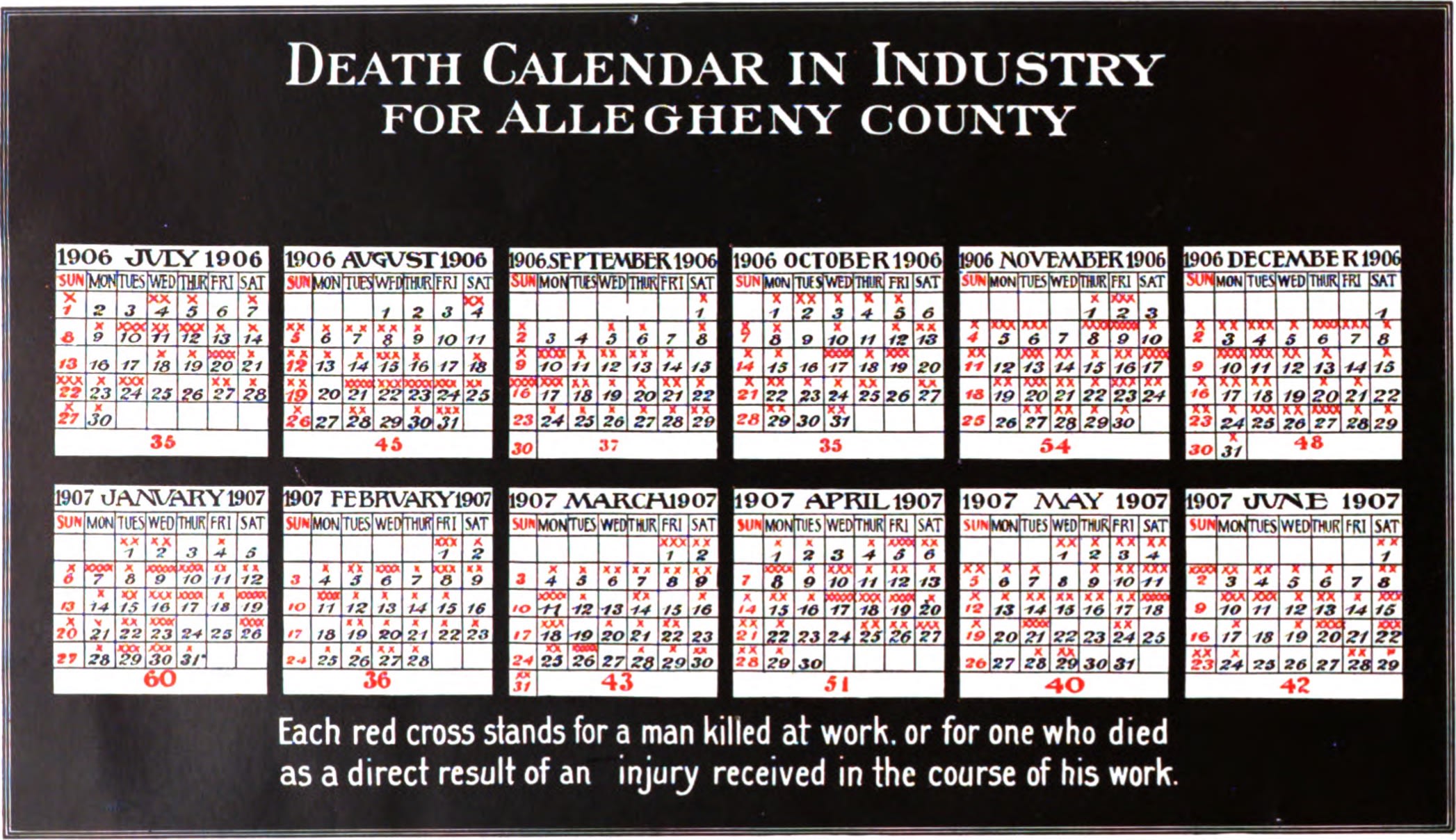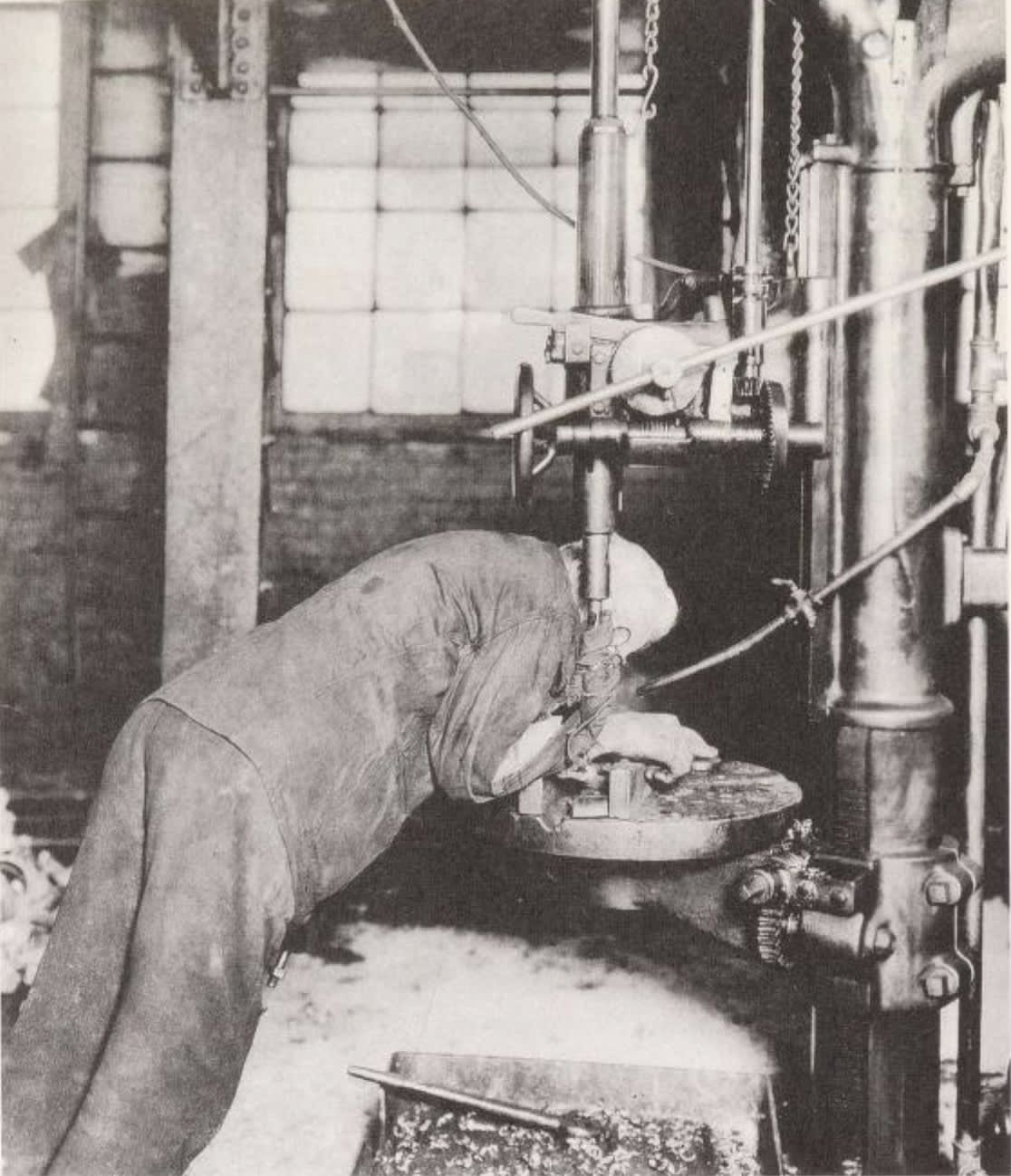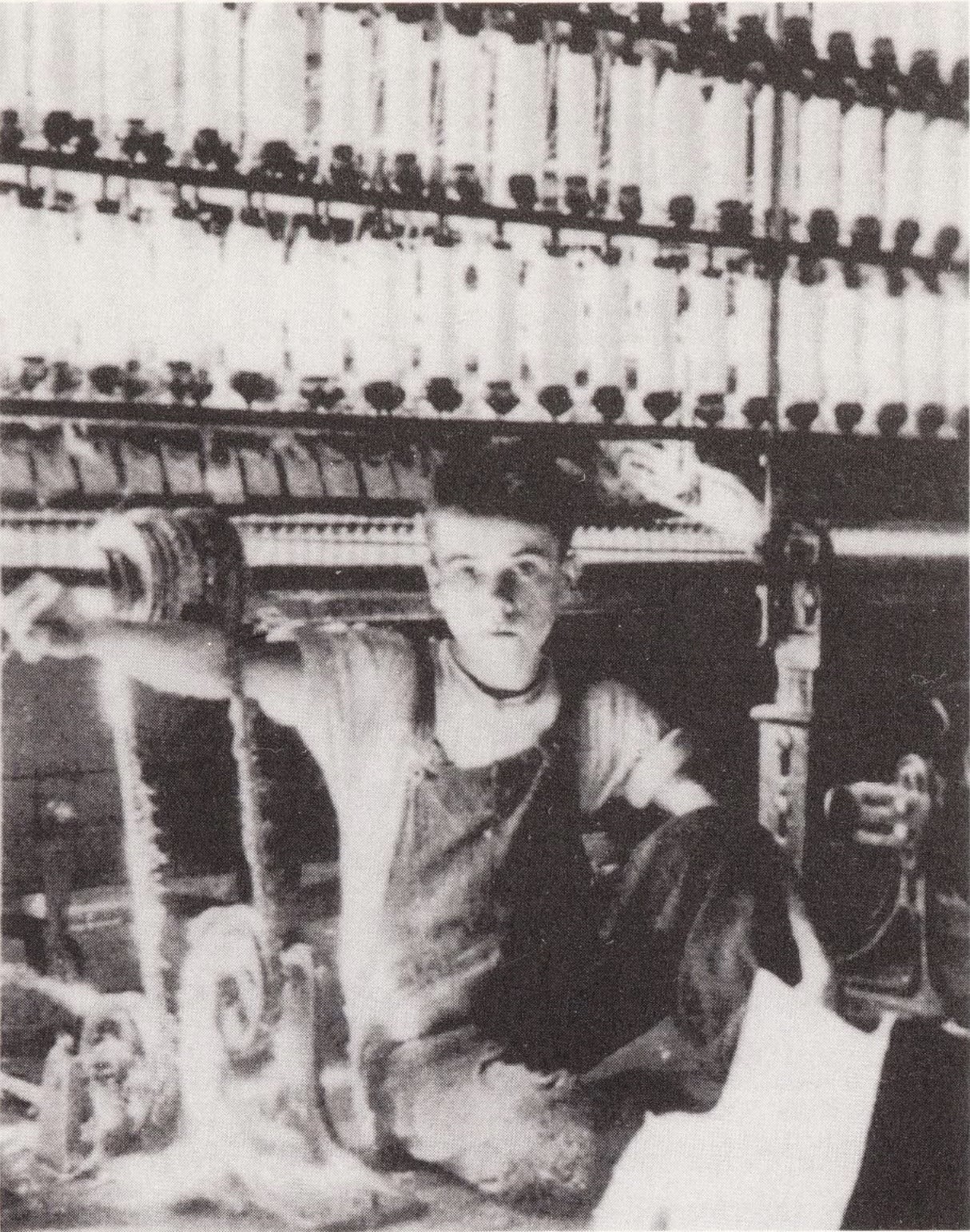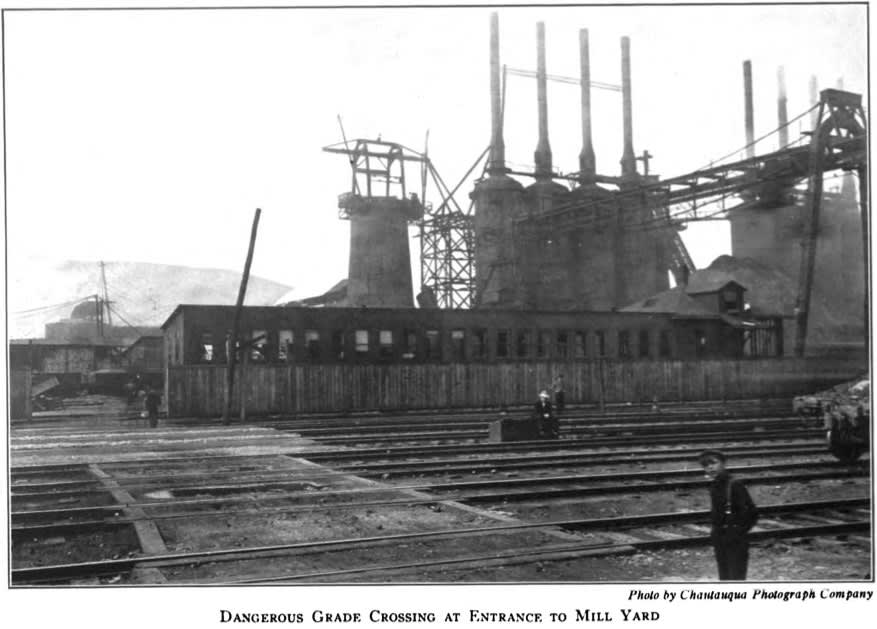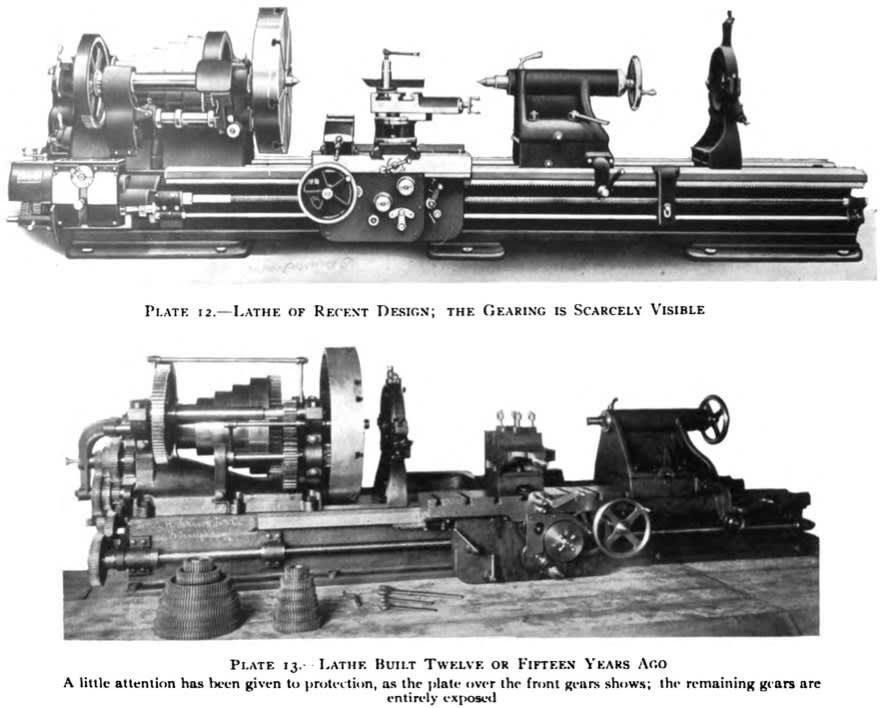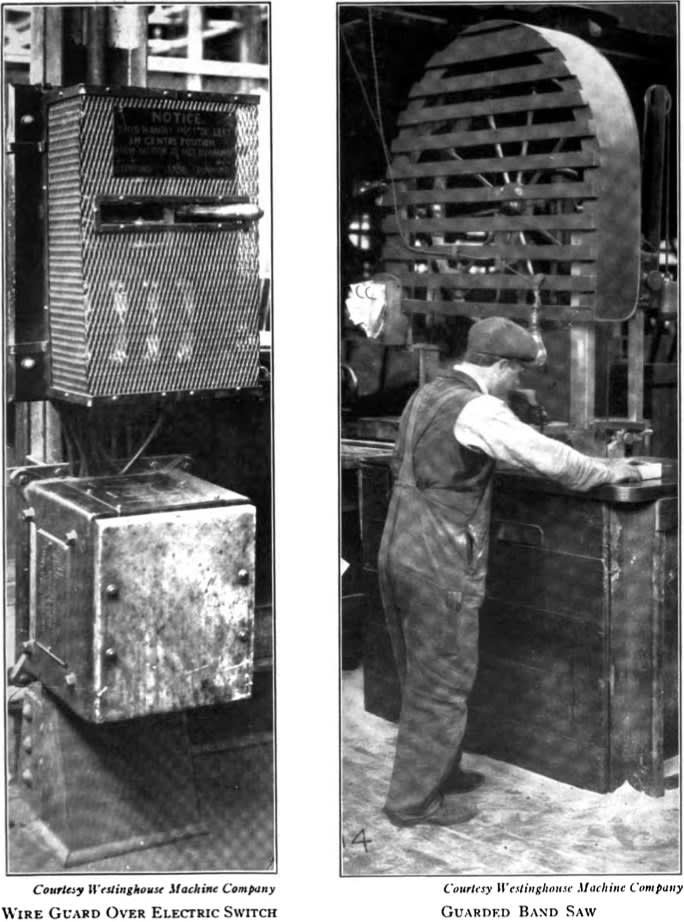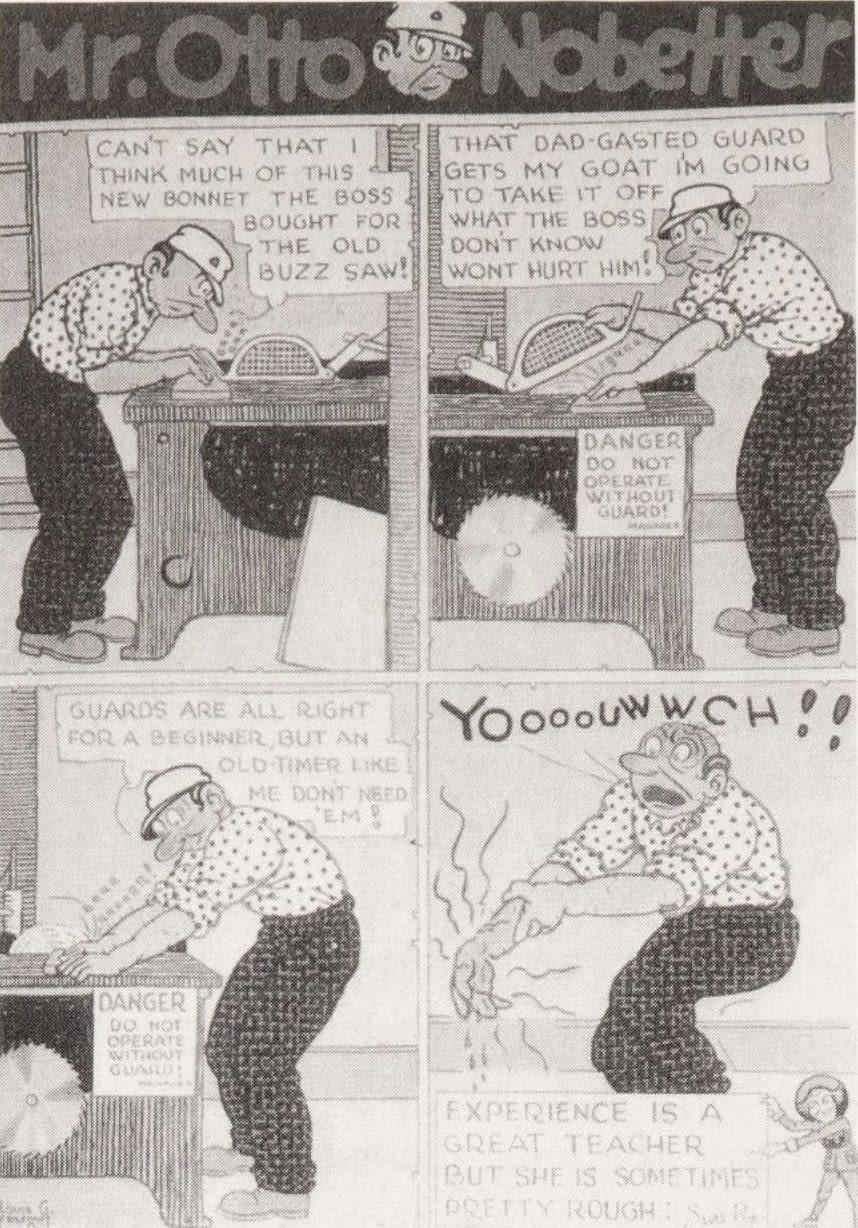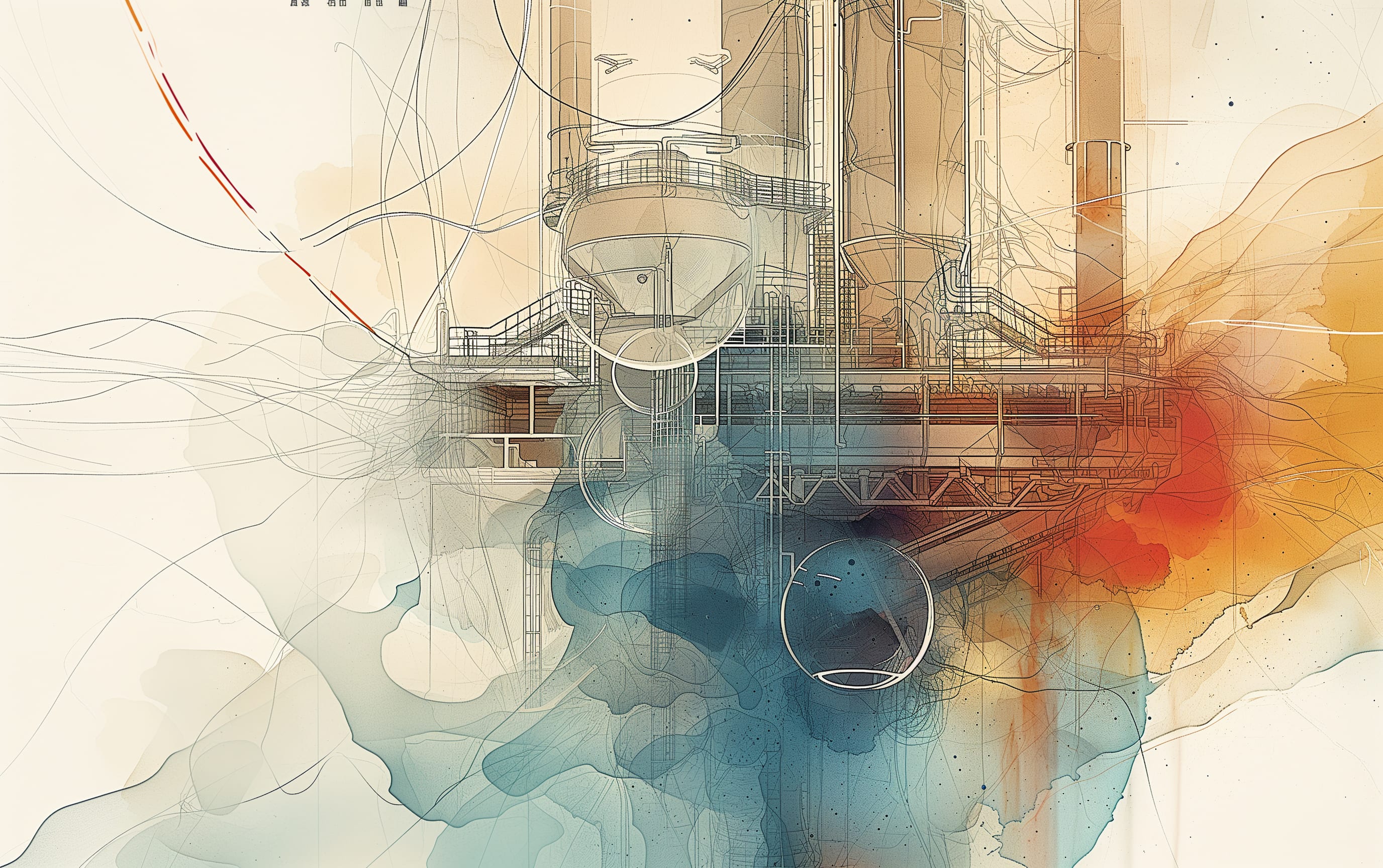
How factories were made safe
25Said Achmiz
22MondSemmel
3Viliam
17uncomputable
6Viliam
15gbear605
8jasoncrawford
1gbear605
2jasoncrawford
5Viliam
2lsusr
14Viliam
8DanArmak
11Viliam
1TAG
2DanArmak
1TAG
2lsusr
9Viliam
2ChristianKl
2Viliam
3ChristianKl
2Viliam
2ChristianKl
14Ruby
7PoignardAzur
12matto
12Viliam
5jasoncrawford
4DirectedEvolution
10ShardPhoenix
9jpsmith
3philh
3jasoncrawford
9philh
6jpsmith
3jasoncrawford
8Jacob Falkovich
4jasoncrawford
8JenniferRM
8Andrew Vlahos
8gwern
1Dojan
3RedMan
0velcro
5jasoncrawford
New Comment
In 1907, according to a report from the Bureau of Labor Statistics, the overall fatality rate in the iron and steel industry was about 220 per 100,000 full-time workers. By 2019, however, that rate had fallen to only 26.3 per 100,000, a reduction of almost 90%.
I was surprised by this reduction number—it seems lower than I expected! If you’d asked me by how much the fatality rate in such an industry had fallen 1907–2019, I would’ve predicted a reduction closer to 99% than 90%.
Why is this? What things kill people in this industry today? And why cannot these causes of workplace fatalities be reduced further?
This question seems susceptible to base rate problems.
The linked document in the quote is by the Bureau of Labor Statistics. It covers fatal occupational injuries, and according to the graph on page 2, the most common category of fatal injuries, by far, is Transportation incidents, which presumably include car and truck accidents.
And page 3 of the report (with a corresponding table on page 9) compares fatal injuries by select occupations, and has fatality rates for "Structural iron and steel workers" at the same rate as "Driver/sales workers and truck drivers", and below e.g. Roofers (2x the fatality rate), Aircraft pilots and flight engineers (2.4x the rate), and especially fishing and hunting workers (5.5x the rate).
Unfortunately the report didn't provide fatality rates for e.g. desk jobs, and I don't have the energy to look those up. Suffice it to say that once you've reached the point where your physically demanding job has a fatality rate on par with fatality rates in car-based professions, it may still be possible to improve, but it probably won't be easy.
What things kill people in this industry today? And why cannot these causes of workplace fatalities be reduced further?
I don't know the first one, but I am pretty sure the answer to the second one is "because that would make things more expensive". (Fundamentally, the same reason why all code isn't unit-tested.) The punishments for workplace fatalities are set externally, the company does the cost-benefit analysis and acts accordingly.
So maybe the solution could be "increase the penalties for workplace injuries/fatalities by a few orders of magnitude, and see how the market reacts", but maybe at some moment weird things would start happening. Like, if the penalty for workplace fatality is paid to survivors, some workers would choose to sacrifice their life for early retirement of their families. Or new types of crimes would appear, for example assassinations of your competitor's workers so that it looks like a workplace fatality, and then because of astronomic penalties your competitor goes out of business. More likely, the employers would find some legal loophole, like forcing the workers to technically become self-employed subcontractors, in which case the worker would become legally responsible for his own death, not his de facto employer.
Workers saw the small daily cost—guards and enclosures on machines are inconvenient, hard hats and safety goggles are uncomfortable and unattractive—and weren’t keenly aware of the rare disaster that would be averted.
Having been a part-owner in an analytical chemistry lab, this attitude continues amongst workers to this day.
No shortage of folks who didn't want to wear closed toe footwear, didn't want safety glasses, would move compressed gas cylinders unsafely, or fail to secure them, etc.
(There were minimal time pressures on the staff; we were more concerned about mistakes that ruined entire batches of work rather than how long anyone took at a given task.)
we were more concerned about mistakes that ruined entire batches of work rather than how long anyone took at a given task.
This looks like a perfect job opportunity for people with high neuroticism! Too bad you probably also require some chemistry knowledge/skills...
Something I think the narrative at the end is overlooking is how the new safety laws came into being.
It was economic progress itself, not muckrakers and labor unions, that solved them.
This implies that the laws would just naturally come into being. However, they had to be specifically advocated for by individuals and groups who supported them. I'm not familiar with the specific laws, but at least the German worker's compensation law originated with a socialist group and was introduced to placate workers. In other countries, I'm doubtful that it was the companies who would have to pay significantly more afterward who supported the laws.
One of the benefits of an organization like a labor union is that it can be a top-down (or at least collectively organized) organization that advocates for laws like these that make sense but not from the perspective of any individual business owner or worker.
Did you read all the way to the end? I feel this was addressed in the last few paragraphs.
(Incidentally, many if not most businesses were in favor of the workers' comp law, even though they knew it would raise their costs. In part that was because they thought it would improve labor relations, although it also may have been because they thought some reform was inevitable and they wanted something moderate to pass before something radical came along. Re labor unions, many of them were actually against workers' comp at first, although Samuel Gompers of the AFL then changed his mind and became for it.)
I did, and I appreciated that you (to the extent you identify with Carla the Capitalist) gave thanks to the people who you oppose ideologically but appreciate for their results anyway.
Again, I'm woefully uninformed about the history here, but: It sounds like there was support for something that would solve the issues but was more radical than workers comp (and presumably wouldn't include the short term pain for workers, and perhaps would be worse overall because of it). If workers comp wound up being a middle ground that all sides would accept then it seems disingenuous to discount worker support for a more radical solution when the compromise worked. Of course, if that's an inaccurate view of the history and the workers and their advocates were really just poorly educated and misinformed about safety, let's hope that they're more informed in our modern day and on other issues.
I'm not sure if there was a specific more-radical proposal on the table, or if that was just a general concern of the businesses. If there was one, I haven't encountered it.
Again, the labor unions actually were originally for the less-radical proposal of simply reforming the tort system (taking away some employer protections) without going all the way to a no-fault system.
The workers themselves seem mostly focused on pay, hours, and other more tangible things.
The workers themselves seem mostly focused on pay, hours, and other more tangible things.
I think Orwell already commented on how left-wing activists speaking on behalf of the working class typically propose dramatic redesigns of the system, while workers typically want... kinda the same thing, only with more pay, more vacation, less abuse, etc.
(Connotationally, I am not mentioning this to say that the left-wing activists are therefore wrong. Some redesign may be needed to switch things to a different equilibrium, while quantitative improvements may slowly revert, e.g. the pay increase will soon be eaten by inflation.)
Do you have the original source for this (even if it's not a quote)? This reflects my real life experience and sounds like the kind of thing Orwell would say but I don't recall encountering it in the subset of Orwell's works I have read. I'd like to read his original writings on the subject.
From The Road to Wigan Pier:
The first thing that must strike any outside observer is that Socialism in its developed form is a theory confined entirely to the middle class. The typical Socialist is not, as tremulous old ladies imagine, a ferocious-looking working man with greasy overalls and a raucous voice. He is either a youthful snob-Bolshevik who in five years' time will quite probably have made a wealthy marriage and been converted to Roman Catholicism; or, still more typically, a prim little man with a white-collar job, usually a secret teetotaller and often with vegetarian leanings, with a history of Nonconformity behind him, and, above all, with a social position which he has no intention of forfeiting. [...] In addition to this there is the horrible—the really disquieting—prevalence of cranks wherever Socialists are gathered together. One sometimes gets the impression that the mere words 'Socialism' and 'Communism' draw towards them with magnetic force every fruit-juice drinker, nudist, sandal-wearer, sex-maniac, Quaker, 'Nature Cure' quack, pacifist and feminist in England. [...] For instance, I have here a prospectus from another summer school which states its terms per week and then asks me to say 'whether my diet is ordinary or vegetarian'. They take it for granted, you see, that it is necessary to ask this question. This kind of thing is by itself sufficient to alienate plenty of decent people. And their instinct is perfectly sound, for the food-crank is by definition a person willing to cut himself off from human society in hopes of adding five years onto the life of his carcase; that is, a person out of touch with common humanity.
[...] it must be remembered that a working man, so long as he remains a genuine working man, is seldom or never a Socialist in the complete, logically consistent sense. Very likely he votes Labour, or even Communist if he gets the chance, but his conception of Socialism is quite different from that of the book-trained Socialist higher up. To the ordinary working man, the sort you would meet in any pub on Saturday night, Socialism does not mean much more man better wages and shorter hours and nobody bossing you about. To the more revolutionary type, the type who is a hunger-marcher and is black-listed by employers, the word is a sort of rallying-cry against the forces of oppression, a vague threat of future violence. But, so far as my experience goes, no genuine working man grasps the deeper implications of Socialism. Often, in my opinion, he is a truer Socialist than the orthodox Marxist, because he does remember, what the other so often forgets, that Socialism means justice and common decency. But what he does not grasp is that Socialism cannot be narrowed down to mere economic justice and that a reform of that magnitude is bound to work immense changes in our civilisation and his own way of life. His vision of the Socialist future is a vision of present society with the worst abuses left out, and with interest centring round the same things as at present—family life, the pub, football, and local politics. As for the philosophic side of Marxism, the pea-and-thimble trick with those three mysterious entities, thesis, antithesis, and synthesis, I have never met a working man who had the faintest interest in it. It is of course true that plenty of people of working-class origin are Socialists of the theoretical bookish type. But they are never people who have remained working men; they don't work with their hands, that is. They belong either to the type I mentioned in the last chapter, the type who squirms into the middle class via the literary intelligentsia, or the type who becomes a Labour MP or a high-up trade-union official. This last type is one of the most desolating spectacles the world contains. He has been picked out to fight for his mates, and all it means to him is a soft job and the chance of 'bettering' himself. Not merely while but by fighting the bourgeoisie he becomes a bourgeois himself. And meanwhile it is quite possible that he has remained an orthodox Marxist. But I have yet to meet a working miner, steelworker, cotton-weaver, docker, navvy or whatnot who was 'ideologically' sound.
In addition to this there is the horrible—the really disquieting—prevalence of cranks wherever Socialists are gathered together. One sometimes gets the impression that the mere words 'Socialism' and 'Communism' draw towards them with magnetic force every fruit-juice drinker, nudist, sandal-wearer, sex-maniac, Quaker, 'Nature Cure' quack, pacifist and feminist in England.
It's interesting to see how this aged. 85 years later, sex-maniacs and quacks are still considered 'cranks'; pacifism and nudists are not well tolerated by most societies, whereas sandal-wearing is more often respected; and vegetarianism and (1930s) feminism are completely mainstream.
Also, I was surprised to learn that Orwell thinks people typically become vegetarian to extend their lifespan, and not for ethical reasons. Was this true in 1930s England? Did Western vegetarianism use to be a fad diet on part with Orwell's "fruit-drinkers"?
I guess that Orwell's objection was something like "these people seem incapable to tone down their middle-class signalling". They ostentatiously care about things that working-class people do not have capacity to care about. They utterly fail at empathy with the workers... and yet presume to speak in their name.
The worker is trying not to starve, and to have enough strength for daily 16-hour work at the factory. Vegetarianism is a luxury he can't afford. Will healthier diet really make him live longer? His main risk factors are falling of the scaffolding, mutilation by an engine, suffocation in a mine, et cetera; how does eating a f-ing tofu protect against that?
For a working-class woman, the lack of right to vote is also not very high on her list of priorities, I suppose.
Therefore, talking about these topics too much is like saying that actual working-class people are not invited to the debate.
Sorry, who is GBS?
Also: if Orwell thought vegeterians expected to gain 5 years of life, that would be an immense effect well worth some social disruption. And boo Orwell for mocking them merely for being different and not for any substance of the way they were different. It's not as if people eating different food intrudes on others (or even makes them notice, most of the time), unlike e.g. nudists, or social-reforming feminists.
Hah, this was my first impression too, when I first read that years before, but let me offer a different perspective here...
1) Middle class better at theory than working class -- is there actually anything surprising here? I mean, if you take a random sample of middle class and a random sample of working class, who would you expect to do better at a math test? Science test? History test? Betting on the middle class is the obvious winning move here, right?
I might go even further and bet on the middle class in many topics that are close to the actual everyday work of the working class, because while I would expect the welders to be highly knowledgeable about welding, cooks to be experienced at cooking, and so on, each specialization is just a tiny fraction of the entire working class, and I would expect the rest of them to drag the average on the specialized knowledge really low; while on the side of the middle class, you get someone who has welding as a hobby, someone who watches a lot of YouTube video about welding despite never actually doing it, many people who remember something from high school physics or chemistry, some people who remember reading some online article about welding, and some answers probably can be guessed just using general education and common sense... so, yeah, I wouldn't be surprised if the group containing all the professional welders (but who make only a tiny fraction of it) to lose at this comparison, too.
Now if you look from a perspective of someone who considers socialism a kind of science -- like a subset or intersection of economics, sociology, history, and whatever -- is it surprising if the working class as a whole sucks at the theory of economics, sociology, and history, and the middle class contains both the actual experts and most of the amateurs?
2) Hypocrisy? Look at the trust fund kids at expensive universities, preaching about social justice and anti-racism, until they graduate, and afterwards many of them become managers and CEOs, measuring the bathroom breaks of their employees, and expanding the prison-industrial complex. But even assuming that most of them are hypocrites, does that make racism the right thing? What about capitalism? (Disclaimer: I am not sincerely comparing capitalism to racism here, just trying to make an argument for someone who might feel that way.)
3) Are many socialists also polyamorous hippies? A similar argument can successfully be made about rationalists; we happen to be more picky about astrology and religion (with the possible exception for Buddhism), but many of us also believe in technological rapture and resurrection of frozen bodies, so maybe we are just more sci-fi flavored, or maybe just living in later century than Orwell's contemporaries. No problem finding a feminist or a vegan at a LW/SSC meetup. Some people take this as a strong argument against rationalists, some don't. Being one of the latter, why should I take it as a strong argument against socialists?
But I agree that it makes a really bad impression... and if you choose to remain a socialist regardless, because you believe in the ideas even if you no longer believe in the people and groups, you are going to be a very lonely socialist... which I think describes Orwell correctly.
1) Middle class better at theory than working class -- is there actually anything surprising here? I mean, if you take a random sample of middle class and a random sample of working class, who would you expect to do better at a math test? Science test? History test? Betting on the middle class is the obvious winning move here, right?
Part of the socialist ideals is that the working class should actually have the power to make a lot of decisions. Believing that the middle class is better goes counter to socialist ideas.
I can't speak for Orwell, or actually any socialist, but there are ways around this.
For example, you might believe that if we improve educational opportunities for the workers (they would support this), then their beliefs will become similar to what the middle-class socialists believe now. In other words, they only disagree because they didn't have time to learn and reflect, but if we provide them more free time (they would support this), they will. That is, in the actual socialism, the decisions will be made by actual workers, and they will be quite similar to what the middle-class socialists promote now.
Also, I think the classes are supposed to be eliminated in socialism.
There's a general idea of starting out with the "rule of the proletariat" after the revolution in Marxist ideology which means actual working class people would govern. They would also govern without first needing to be educated for that.
Social democrat ideology doesn't have the same issue but the Marxists do have it.
I can't simulate a (non-Leninist) Marxist well enough to answer this. Yes, when you put it this way, it sounds too naive.
Leninism assumes a "vanguard" that will lead the proletariat towards its coherent extrapolated volition.
Mondragon Corporation has management, but the workers-owners can vote them out. No idea what Marx would think about this.
The idea that people are equal in the sense of one hour of work being the same is one of the cornerstones of Marx's work.
Curated. There's much to love in this post. It's a killer example of the role incentives play that hits home even when you know many others. It's a surprise to hear the cause of change. And it's fascinating to learn how indifferent workers are to own safety; but hearing, I suppose it's not so different from how people are indifferent to their mortality now.
Not surprised at all. My father is a roofer and mostly works with African immigrants, and to hear him tell it, the biggest difficulty regarding workplace safety is getting them to wear the damn protective gear (mostly hard hats and gloves), for the reasons outlined in the article.
(From what I've heard from journal articles and the like, the other big problem in the sector is that they'll hire a lot of undocumented immigrants who lie about how qualified they are to get the job; which is another version of the same "workers will break all the safety rules written to protect them if the economic pressure is strong enough" issue.)
It seems to me that a similar shift in thinking is taking place in the software industry under the label of "SRE."
(Disclaimer: I'm a site reliability engineer)
You write:
Thus, accidents were typically attributed to worker “carelessness.” (...) Since the contribution of the work environment to safety was not yet acknowledged, accidents were seen as largely unavoidable. (...)
Replace the word "accidents" with "bugs" and you have a pretty accurate picture of software development up until about 2000, or so the greybeards and some of my history readings tell me. Basically, each aspect of writing a program was highly individualized, with developers collecting cool tricks like efficient algorithms or highly reusable functions. Some of this was passed on person to person, but a lot of it simply vanished when someone changed jobs.
Then, things started to get better, with things like automated testing becoming mainstream, until we started building applications that ran on distributed systems. That level of complexity couldn't be adequately handled in order to provide a reliable service. This was at a time when stuff like google maps or email were becoming ingrained in people's daily lives. So we began talking about "devops" - a way for developers (who built applications) and operations (who ran the applications) to collaborate. And to cut a long story short, at some point the SRE paradigm was born, which I consider an implementation of the ideas that devops generated. SRE itself is very similar to this:
The new corps of safety engineers began fixing the root causes of injuries. They put guards and enclosures around the moving parts of machines. They invented locks for the machines, so that they couldn’t be turned on unless those guards were in place. They created automatic shutoff mechanisms.
My day to day involves tracking down (root-causing) outages, improving observability (ensuring good signal about system health), automating everything from deployments to developer tooling in order to decrease the risk of a breaking change making its into production and taking the service down. The key difference now is that my work doesn't save any lives, but I like to think that it makes the lives of my users and colleagues better.
Also, this rings extremely true:
The new corps of safety engineers began fixing the root causes of injuries. They put guards and enclosures around the moving parts of machines. They invented locks for the machines, so that they couldn’t be turned on unless those guards were in place. They created automatic shutoff mechanisms.
I've gotten a good deal of pushback from experienced developers who consider the whole devops/SRE thing a passing fad, who also think that minutes or hours of downtime is part of the game, and that there's simply no way around bugs and that we're all doomed to mitigate outages at 3am on Sundays.
you can’t agree to waive your right to a living wage, shorter hours, etc.
now you’re not talking about injury, but benefits. You’ve flipped from negative rights, the right not to be injured, to so-called “positive rights”, such as pay and convenient hours.
Is there actually a clear line between negative and positive rights? For example, if sleep deprivation is a health risk, and someone hypothetically has to work literally 20 hours a day, is being hurt by lack of sleep fundamentally different from being hurt by a piece of metal or being poisoned by gas?
I think there is a clear line. If you take the job at 20 hours/day, you know what you've signed up for. You didn't sign up to be injured in an accident. The liability for that needs to fall somewhere.
(You could argue that workers signed up for certain risks, and this is exactly what employers used to argue in many cases. And I'm not 100% sure that's wrong. So I am still slightly ambivalent about this.)
You could argue that workers signed up for certain risks, and this is exactly what employers used to argue in many cases.
Is a person's level of responsibility for the risks they assume proportional to the level of knowledge they had about those risks in advance?
Here's a line of thinking we might imagine in the mind of a worker taking full personal responsibility for an unknown level of risk:
I need a job, and working in the steel mill seems like good-paying work. But I know that people get hurt or killed there, sometimes. I'll try to be careful, but I can't control what other people do, and the equipment isn't too reliable either. Plus, I might have a bad day, be forgetful, and cause a disaster. I don't want to die for this job. But I don't know how likely it is that I'll get hurt or killed, and it's hard for me to say whether or not, if I really knew my true chances, I'd feel this was the job for me... I guess I'll do it, though. What am I going to do otherwise? Something else that's just as dangerous? Or lower-paying?
This line of thinking seems like a plausible account of how a cautious person might have tried to do a risk assessment for factory work. I don't look at it and think "clearly, this man is fully liable for anything that happens to him in the steel mill." Nor do I look at it and think, "anything that happens to this man is his employer's moral and fiscal responsibility."
Instead, I tend to think that we should do our best to get an expert assessment of the risk, make the factory as safe as we can, create a culture of safety, and take care of people who get hurt - both for their sake and so that we can keep a feeling of relative confidence in the workers who will continue to do the job after one of their colleagues suffers an accident. Having the moral debate is a symptom that your system has broken down and can't find a satisfactory deal for everybody. It feels like camoflage for a business negotiation rather than a true intellectual debate. Real progress is having to have fewer moral debates.
This was a very informative read. One thing I've been wondering about a lot lately is to what extent innovation relies on exploiting unpriced externalities, and I think this piece provides a good example.
As you note, the key issue is that safety in a factory involves externalities, and the workman's comp laws effectively internalized the cost of those externalities to the firms. If the workman's comp laws had been in place from the beginning (or if the externalities had otherwise been internalized from the beginning), how would that have changed the course of innovation and technological progress? Would innovation have slowed down, or would we have missed out on some innovations altogether, because it would have been too costly for firms to operate when they were fully internalizing all their external costs from the beginning?
I've mostly been wondering this in the context of pollution, but I think it applies to worker safety too after reading this.
Are these externalities, in the relevant sense? The cost is to the workers, and the workers are at the table - we might expect them to demand more money in exchange for the job being dangerous. So modeling this as "internalizing externalities" feels like a weird fit.
On the other hand, given that the workers actively resisted safety measures... I dunno.
I think of “externality” as roughly equivalent to “you hurt someone and you didn't have to pay for it.” If a workplace is neglectful of safety, and the worker gets hurt, and the employer doesn't have to pay, that seems like an externality?
Caveat that I'm not an economist, but my sense is that's not a great way to think about externalities.
The problem is, what does it mean to "pay for" something? If I buy a bag of chips, did I pay 50¢ for the taste and feeling of satiation, and also get an increased risk of heart disease? Or did I pay "50¢ plus increased risk of heart disease" for those things?
If people who went to work in a steel mill knew that it had a higher risk of dying than other jobs that were available, maybe they decided that they were being fairly compensated for the risk of death? (Even if they did decide that, that doesn't mean these changes were bad.)
Wikipedia has it that an externality is "a cost or benefit for a third party who did not agree to it". (Benefits come from e.g. vaccines, where I might get one for selfish reasons but it happens to protect those around me.) In this case, there might be a question about whether the steel workers agreed to the cost, but they're not a third party.
And whether they're a third party matters, I think, because if we decide there's an unfair outcome happening, the tools available to us depend a lot on whether the person being harmed gets a say in the matter. Things like nutritional info, energy ratings, "smoking causes lung cancer" warnings, are ways to help people decide what is or isn't worth it for them, but they mostly only help the person deciding whether or not to buy something. ("Mostly" because health and energy usage do have their own externalities.) If we want to help someone who doesn't get a say in the transaction, we apply different tools, like taxes and regulation.
(I guess I've changed position from my previous comment, I now just think "no, this isn't an externality". Workers resisting safety measures is important, like it feels like the kind of thing that if you apply economic tools to make predictions it's not at all what you'd expect and it seems like this points at an important limitation of economic tools. But that doesn't turn this into an externality.)
I guess thinking of this in terms of externalities maybe isn't quite right. It might be more useful to say that system-level safety is a public good, since, for all the workers in a particular firm, safety would be non-rival (one worker benefitting from a safety measure doesn't prevent other workers from benefitting) and non-excludable (nobody can exclude a particular worker from benefitting from the system-level safety measures).
Each worker only has an incentive to look out for their own safety, not to implement any system-level safety measures. Before the workman's comp laws, firms also didn't have an incentive to provide the system-level safety public good--the cost of providing it must have outweighed the benefits to the firm. The workman's comp law then shifted the cost/benefit ratio of providing the system-level safety public good enough to make firms start providing it.
This mental model seems to line up with a couple observations from the essay: First, workers resisted some safety measures when they had to bear some of the costs of providing the public good by changing their working styles. They were probably especially resistant if they felt that the marginal cost they personally bore in providing the good was greater than the marginal benefit they received from it. Second, larger firms would have higher benefits from providing this public good (or higher costs of not providing the good), which is why they led the way on implementing system-level safety programs.
I don't think it would have significantly slowed things down. I think the costs to employers went from like a fraction of a percent of payroll to a few percent. It was a big relative increase, but still a fairly small cost overall. But it was just big enough to make them say “we should have a safety department.”
This was a very interesting read. Aside from just illuminating history and how people used to think differently, I think this story has a lot of implications for policy questions today.
The go-to suggestions for pretty much any structural ill in the world today is to "raise awareness" and "appoint someone". These two things often make the problem worse. "Raising awareness" mostly acts to give activists moral license to do nothing practical about the problem, and can even backfire by making the problem a political issue. For example, a campaign to raise awareness of HPV vaccines in Texas lowered the numbered of teenage girls getting the vaccine because it made the vaccine a signal of affiliation with the Democrat party. Appointing a "dealing with problem X officer" often means creating an office of people who work tirelessly to perpetuate problem X, lest they lose their livelihood.
So what was different with factory safety? This post does a good job highlighting the two main points:
• The problem was actually solvable
• The people who could actually solve it were given a direct financial incentive to solve it
This is a good model to keep in mind both for optimistic activists who believe in top down reforms, and for cynical economists and public choice theorists. Now how can we apply it to AI safety?
Note that “raising awareness” was actually an important part of the factory safety story. It can be useful if it is channeled into actual solutions (and, to your point about the HPV vaccines, if there isn't too much political tribalism going on such that any issue immediately becomes polarized).
I like the essay!
It seems good and helpful in general for noticing a positive thing that happened, in history, that could serve as a positive case study, and I learned a lot from reading it.
If there is maybe a missing piece... I don't see a clear model of balancing tests? In this case it seems likely that the best path through the Friedman Spaghetti Diagram might have been selected, but like... HOW?
Everything has a cost, and everything has a benefit. Institution design is like chainsaw design: it can be done well or poorly. If safety is so great, then why not have infinite amounts of safety? Surely umeshisms for safety apply just as much as for being late to things?
I'm not sure exactly what the tradeoffs here are, but I think maybe (1) "fraud" and (2) "making it de facto illegal for marginally competent people to own or run businesses that aren't particularly unsafe" might be more of a problem lately?
The fraud side of things is easier to illustrate, so I shall focus on that.
...working the example...
I would be quite surprised if there was LESS than $1B/year in worker's comp fraud in the US but I would also be surprised if there was MORE than $1T/year.
Just hypothetically (to illustrate the math) if lives are worth $10,000,000=10^7 each and yet fraud per year amounted to $1,000,000,000,000=10^12 then (assuming we can take dollars as a valid unit of caring ...and so on with "assume a spherical cow" simplifications) the two things would be a similar "amounts of badness to the common good" if there were 100,000 people=10^5 dying in industrial accidents every year.
Just be clear on the math: 10^12/10^7 = 10^(12-7) = 10^5 = 100,000.
I think the actual amount of fraud is maybe $3*10^10 and the actual amount of industrial deaths per year is roughly 5*10^3 lives? (The ratio I calculate is close enough to 1.0 that I'm slightly impressed. Did someone cause this? Who?)
But then also: just as cows are not spherical, similarly there's almost certainly other costs or benefits to consider.
Maybe fraud isn't even the worst part, because other things are worse or maybe fraud in such cases isn't so bad because, I dunno... maybe stealing from insurance companies is somehow praiseworthy (and hilarious to watch when caught on tape)?
I don't think this is true (the praiseworthy part is probably mostly false (the funny to watch part is kinda true))...
...generalizing some...
...humans engaged in moral discussion, are, in my experience, capable of incredible feats of mental gymnastics when the topic switches to differential benefits and losses, and the proper allocation of credit and blame. These topics are, empirically, not simple matters to reach agreement on.
I'm in favor of engineering things to be Intrinsically Safe because that's just good design <3
I'm in favor of well designed nuclear power plants and against poorly designed nuclear power plants because: (1) cheap clean power is intrinsically awesome... unless (2) it causes a poisonous explosion by accident. But then like: Duh? Is this not obvious to someone?
I'm in favor of having properly designed BSL-5s (in rural places, surrounded by prison fences and a kill zone, with quarantine cottages so people on their way OUT according to Intrinscally Safe procedures have time for the longest possible disease to incubate inside them while they wait in the cottage for their second round of exit tests, and with armed guards who never enter the facility enforcing the boundary) and I'm even in favor of Gain-of-Function (GoF) research on horrible diseases... conditional on the research happening inside a BSL-5... because: (1) knowing how to treat and model and understand terrible communicable diseases is probably good, but then (2) spreading terrible communicable diseases by accident is bad, and then (3) intentionally spreading diseases around the world is even worse. But then like: Duh? Is this not obvious to someone?
The central problem feels to me like its that "obvious things are somehow not obvious to most people"?
Also, empirically, people cheat and lie for their own benefit a lot? But ALSO humans often deny that humans often cheat and lie for their own benefit! Its weird. Maybe Hanson understands it since he seems to have noticed big mechanistic chunks of related psychology so long ago.
Not really helpful for understanding the history of factory safety, but here's a funny German workplace safety video, Forklift Driver Klaus: (note, you do not need to speak german)
I second the comment about workers not caring. If you're on a job site being the person who tells people to make sure they're properly tethered, gets a hose for the dust hazard, or make demands about grounding the electricity before doing work...you won't be popular.
System-Theoretic Process Analysis (STPA) STAMP and CAST from Nancy Leveson at MIT is an absolutely amazing tool for thinking and I recommend anyone interested in hazard analysis and protection look at it. It is revolutionary for safety analysis of industrial processes in general, but I don't think I've ever seen anyone attempt to apply its' principles to AI risk (if I'm wrong, please link the work, I'd love to read it).
Overall, I found this very informative. One quibble:
Shorter hours, cleaner and safer factories, and the end of child labor are luxuries that could only happen after an increase in per-capita wealth.
The per-capita wealth is at least one level removed as a cause. The actual cause is increased profit for the factory that can be turned in to those benefits. Do you have any evidence that early unsafe factories had insufficient profit for that to happen? Is it safer to assume that the owners felt no pressure to give up their generous profits for the benefit of worker safety?
To be clear, you're quoting a sentence from a paragraph that I described as “one possible narrative”, in a section where I described two opposing narratives and then explored which aspects of each seemed to be supported by this story.
I do think that safety measures could have begun earlier. See my reply to jpsmith: https://www.lesswrong.com/posts/DQKgYhEYP86PLW7tZ/how-factories-were-made-safe?commentId=wAPgdiJNHsYewmrzi
Curated and popular this week
